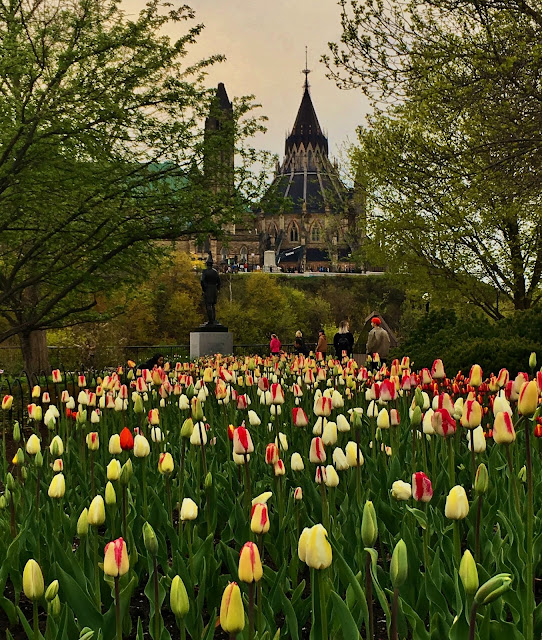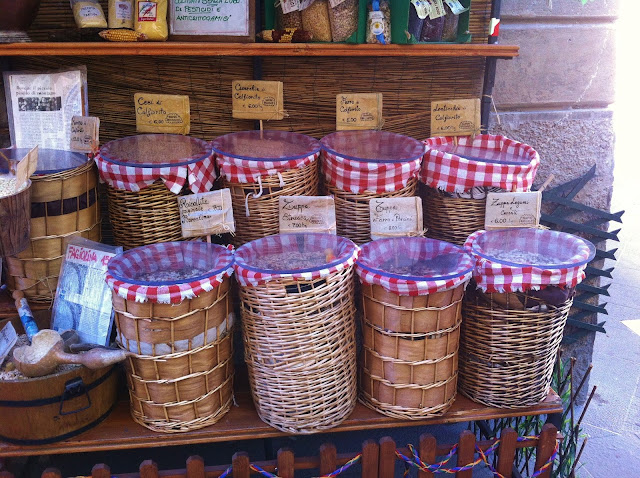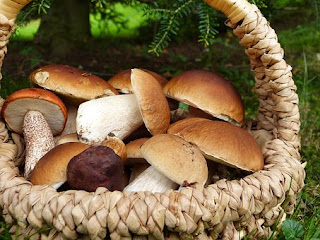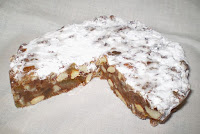We hear the cling of bicycle bells echoing under a stone bridge and the honk of geese from the sparkling waters of the adjacent canal as we glide past beds of colourful tulips. Are we in Amsterdam? No, we are in Ottawa, Canada for The Canadian Tulip Festival!
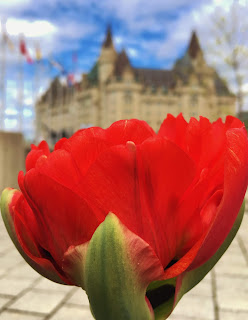 |
| Château Laurier |
Spring is a gorgeous time to visit Canada's capital of Ottawa. The weather is mild, the international tourist crowds are still relatively thin, and tulips abound in all the flower beds around the city. The Canadian Tulip Festival occurs every May for about 10 days and kicks off the summer festival season with a burst of flowers and fireworks!
The History of the Canadian Tulip Festival is quite unique. In 1940, during World War II when the Nazi forces invaded the Netherlands, the Dutch Royal Family had to flee their home and came to live in Ottawa. In 1943 Princess Juliana (who later became the Queen of the Netherlands) gave birth to Princess Margriet in Ottawa Civic Hospital. In order to be born Royal, the Princess had to be born on Dutch soil, so the hospital maternity ward was temporarily declared "extraterritorial" meaning the ward was considered international soil. In this way, Princess Margriet claimed the nationality of her mother, which is Dutch law. Otherwise, Juliana's baby would have been a dual Canadian/Dutch citizen and therefore not be able to be in succession for the Dutch throne.
 |
| Bright Beds of Tulips Everywhere |
In 1945 the Dutch Royal Family returned home, and Princess Juliana gifted Ottawa 100,000 tulip bulbs. Every year since then the Dutch Royal family has gifted the city of Ottawa 20,500 tulip bulbs, and in 1953 The Canadian Tulip Festival was born. Drawing more than half a million visitor to Canada's capital, the ten-day festival has become one of Ottawa's biggest and longest-running celebrations.
Tulips are plentiful all over Ottawa's parks, gardens and boulevards during mid-spring especially around the Canadian Parliament, along the Rideau Canal and Dow's Lake. The Tulip Festival usually had multiple locations, but this year in 2019 the festival was concentrated in one area; Commissioner's Park on Dow's Lake.
The best place to find out current information on The Canadian Tulip Festival is on the official Tulip Fest website: tulipfestival.ca or on the official ottawatourism.ca website.
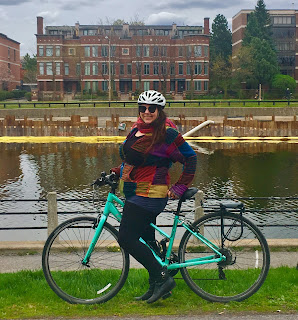 |
| Cori Biking Along Rideau Canal |
The Ottawa Tulip Festival ends on Canada's Victoria Day Long Weekend (the Monday before May 25th; Queen Victoria's birthday) which is the unofficial kickoff to summer in Canada. My friend Cori and I decided to make the trip a four-day weekend, taking the Friday and the Holiday Monday as travel days to Ottawa from South West Ontario; about a 6-hour drive. This will give us more than a full two days to explore Ottawa.
Ottawa's downtown core is quite compact and easy to navigate, with most of the major tourist attractions all within walking distance of each other. Getting to the site of this year's Tulip Festival at Commissioner's Park in South Ottawa was going to part of the fun. We decided to walk downtown and rent bikes and ride them along the Rideau Canal to Commissioner's Park at Dow's Lake; about a 13 km loop trail.
 |
| Map Of Our Tulip Festival Tour |
Ottawa is a bicycle haven with numerous bike paths and city streets with designated bike lanes; renting bikes was super fun and easy. We looked into a public bike share program, but the website was a bit confusing, and we had troubles finding the pick-up and drop-off locations. Also, we didn't want our bikes to get picked up by another rider while we tip-toed through the tulips at Dow's Lake, leaving us stranded at the festival. So we decided to head to the RentABike location on the Rideau Canal just under the canal bridge in front of the Chateaux Laurier.
TIP: At RentABike everything is included, the bike, helmet, lock, maps, a bungee cord to secure my raincoat to the bike rat trap and of course a sweet little bell on the handlebars! We chose to rent our bikes for 4 hours, and it came to a total of $25, including taxes. Here is the RentABike website: www.rentabike.ca
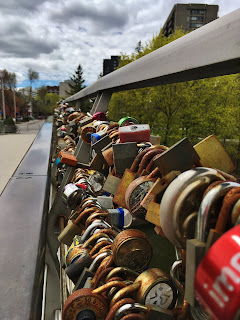 |
| Love Locks on the Canal... |
 |
| Rideau Canal Leading To Château Laurier |
Zipping along the shared pedestrian/bike path we were told to cross the Rideau Canal at the third bridge due to the ongoing construction of the canal on the east side in 2019.
The ride along the Rideau takes you along canalside pathways, under stone bridges and then up to tulip-lined boulevards, past the giant sports stadium only to return back down to the canal where it is quiet, and the chatter of ducks is louder than the people strolling by.

Once we arrived at Dow's Lake, we were overwhelmed with crowds of tulip lovers congesting the bike paths, so we decided to dismount and lock up the bikes and make inroads to the Tulip Festival by foot. TIP: If you are arriving by car, there is a designated parking lot at Queen Juliana Park a short walk away from Commissioner's Park. All day parking is $15; see the Tulip Fest website for more information.
Gorgeous beds of colours bursting out from the gardens in some of the most resplendent tulips I have ever seen! I am not a tulip aficionado by any means, but some of these varieties of tulips seemed so extravagant. The atmosphere in Commissioner's Park was so festive; there was a band shelter with a brass band playing and tones of food trucks with all sorts of delightful ethnic spices wafting over the crowds. Kids were running around the park in facepaint and bouncy castles were set up so the kids could work off their sugar rushes. TIP: Public washrooms are sparse throughout the park and the line up for the Portable butt-huts was almost an hour long in some cases!
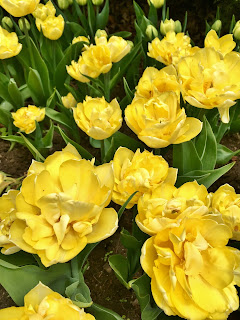
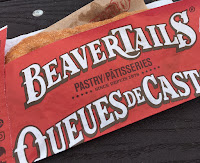 |
| Yum! |
 |
| Sunshine & Tulips; A Perfect Spring Combo |
Bellies full of exotic Canadian pastries and sugar coursing through our veins, we decide to hop back on our rental bikes and head back to the city centre to return our rentals. The sun was shining, and the promenade along the canal entertained more people at this time, especially families with small kids in tow. There were a few boats on the canal, and as we glided past the non-anglophone speaking locals, I couldn't help think that this must be a taste of what Amsterdam must be like. I am inspired to find out!
The day ended with a blazing fireworks display over Dows Lake, and access to Commissioners Park was again free. TIP: The fireworks parking scene at night is just as bad as the daytime parking at Queen Juliana park so perhaps consider walking, biking or public transit to avoid getting stuck in the post-fireworks traffic jam.
The Canadian Tulip Festival is one of my favourite festivals in Ontario and left me pondering this: if Montreal and Quebec City is Canada's version of France, and St. Johns Canada's version of Ireland then imaginably Ottawa is Canada's version of the Netherlands.
Have you been to Ottawa in the Spring or to The Canadian Tulip Festival? What was your favourite activity? Let me know in the comments below.
Follow me on FACEBOOK, INSTAGRAM and BLOGLOVIN' for daily photos and updates! #slowtravel🐌
